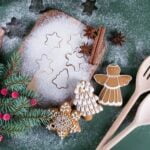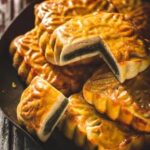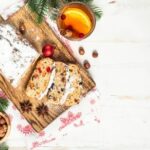The enchanting charm of the holiday season can be captured in many ways, but perhaps none as delicious and visually stunning as Christmas cakes decorated with intricate designs. These edible works of art showcase the creativity and festive spirit that define the Christmas season. From whimsical winter wonderlands to jolly Santa’s workshops, these cakes not only taste amazing but also serve as centerpieces that bring joy to any gathering.
When it comes to decorating Christmas cakes, there is a rich history rooted in tradition and cultural significance. By unraveling the origins of this art form, we can appreciate how it has evolved over time, incorporating various techniques and themes. Understanding the history will give us a newfound appreciation for the magic behind these delectable confections.
In this article, we will explore the different types of Christmas cakes that can be decorated, ranging from traditional fruitcakes to modern chocolate delights. We’ll dive into the essential tools and ingredients you need to elevate your baking game and create stunning decorations that will leave your guests in awe.
Furthermore, we’ll provide a step-by-step guide to help you unleash your artistic skills and turn an ordinary cake into a festive masterpiece. So get ready to embark on a journey through the magical world of Christmas cakes decorated.
History of Decorated Christmas Cakes
The history of decorated Christmas cakes is a fascinating journey that takes us back hundreds of years. The tradition of decorating cakes for Christmas can be traced back to ancient civilizations, where they were made as offerings to gods and spirits during winter solstice celebrations. As these celebrations evolved over time, so did the traditions surrounding Christmas cake decorations.
One of the earliest recorded instances of decorated Christmas cakes dates back to medieval times in Europe. During this period, fruitcakes were popularly made during festive seasons due to their long shelf life and ability to withstand long journeys. These fruitcakes were often richly spiced and filled with dried fruits, nuts, and honey. They were then elaborately decorated with edible gold leaf, icing sugar, and intricate designs made from marzipan.
In Victorian England, the art of decorating Christmas cakes became more elaborate and intricate. Queen Victoria’s love for all things opulent greatly influenced the decorations used on Christmas cakes during her reign. Marzipan was still a popular choice for creating decorative elements such as flowers, fruits, and figures. It was also during this time that royal icing gained popularity as a smooth and elegant covering for Christmas cakes.
| Historical Period | Main Decorative Elements |
|---|---|
| Ancient Civilizations | Edible gold leaf, icing sugar |
| Medieval Times | Fruits, nuts, honey; marzipan designs |
| Victorian Era | Marzipan flowers, fruits, figures; royal icing |
Today, the tradition of decorating Christmas cakes continues to evolve with new techniques and styles. Fondant has become a popular choice for covering cakes, providing a smooth and polished finish that can be easily molded into various shapes and designs. Modern cake decorating tools and equipment such as piping bags, edible food dyes, and stencils allow bakers to create intricate patterns, textures, and even personalized messages on their Christmas cakes.
The history of decorated Christmas cakes is not just limited to the Western world. Many cultures around the globe have their own unique traditions when it comes to decorating festive cakes during the holiday season. For example, in Japan, Christmas cakes are often adorned with winter-themed decorations like snowflakes made from white chocolate or delicate sugar sculptures depicting scenes of nature.
In summary, the history of decorated Christmas cakes is steeped in tradition and innovation. From ancient civilizations to medieval Europe and the modern era, people have found joy in creating beautiful edible works of art to celebrate the festive season. As we continue to embrace new techniques and explore different cultural influences, the art of decorating Christmas cakes will undoubtedly continue to evolve and inspire bakers around the world.
Types of Christmas Cakes
When it comes to Christmas cakes, there are a wide variety of options to choose from. From traditional fruitcakes to modern chocolate delights, each type of cake brings its own unique flavor profile and aesthetic appeal to the holiday table.
- Classic Fruitcake: The classic fruitcake is a staple in many households during the festive season. Packed with dried fruits, nuts, and spices, this dense and rich cake is often soaked in alcohol for added flavor. It is then typically covered in marzipan or fondant icing and decorated with festive designs such as holly leaves or snowflakes.
- Gingerbread Cake: Gingerbread is synonymous with Christmas, and a gingerbread cake brings that warm and spicy flavor to your dessert table. Often made with molasses, ginger, cinnamon, and cloves, this dense and moist cake can be topped with cream cheese frosting or simply dusted with powdered sugar.
- Yule Log: Also known as Buche de Noel, the Yule Log cake is shaped like a log and traditionally made of sponge or genoise cake rolled up with buttercream filling. The outside of the log is covered in chocolate ganache or buttercream to resemble bark, and it can be decorated with meringue mushrooms or fondant decorations resembling woodland scenes.
- Chocolate Peppermint Cake: For those who love the combination of chocolate and mint flavors, a chocolate peppermint cake is an excellent choice for Christmas celebrations. This moist chocolate cake can be layered with peppermint-flavored buttercream or ganache and adorned with crushed candy canes for an extra festive touch.
- Eggnog Pound Cake: Eggnog isn’t just for drinks – it also makes a delicious addition to cakes. An eggnog pound cake combines the flavors of eggnog – such as nutmeg and rum – into a rich and tender cake that pairs perfectly with a cup of hot cocoa on a cold winter’s night.
No matter which type of Christmas cake you choose, decorating it can be a fun and creative process that adds an extra touch of festive cheer to your dessert table. With a wide variety of flavors and designs to choose from, the possibilities for creating a stunning Christmas cake are truly endless.
Essential Tools and Ingredients for Decorating Christmas Cakes
Introduction
Decorating Christmas cakes is a delightful tradition that brings joy and excitement to the holiday season. Whether you are an experienced baker or just a beginner, learning about the essential tools and ingredients for decorating Christmas cakes will help elevate your baking game and create stunning masterpieces. In this section, we will explore the key tools and ingredients you need to make your cakes not only look beautiful but also taste delicious.
Tools for Decorating Christmas Cakes
To achieve professional-looking cake decorations, you will need a few essential tools. The first must-have tool is a piping bag and various tips. Piping bags allow you to create intricate designs and patterns on your cake, while different tips provide versatility in creating various shapes such as stars, flowers, and letters.
Additionally, an offset spatula comes in handy for smoothing frosting and spreading fillings evenly. A bench scraper is essential for achieving smooth sides on your cake while removing excess frosting.
Another important tool is a turntable or rotating cake stand. This allows you to easily spin the cake while decorating, giving you better control and precision in applying frosting or adding details. A set of cake decorating brushes helps add delicate touches and fine details to your creations. And don’t forget about a good pair of sharp scissors for cutting fondant or trimming decorations.
Ingredients for Decorating Christmas Cakes
Besides the necessary tools, having the right ingredients is crucial for creating beautifully decorated Christmas cakes that taste as amazing as they look. The main component is the cake itself – whether it’s a classic fruitcake or a moist chocolate sponge cake. Other ingredients like buttercream frosting, royal icing, fondant, and marzipan are commonly used for covering cakes or creating decorative elements.
Food coloring gels or liquid food coloring are essential for tinting frostings or fondant if you want to achieve specific colors for your decorations. Edible glitter adds sparkle and magic to your cakes while edible pearls or sprinkles provide texture and visual interest. Depending on your design, you may also need gum paste or modeling chocolate for creating more intricate figurines or toppers.
With the right tools and ingredients, decorating Christmas cakes can become a joyful and rewarding experience. Incorporating these essential elements into your baking routine will help you take your cakes to the next level, allowing you to showcase your creativity and bring joy to those who indulge in your festive creations. So gather your tools, stock up on ingredients, and get ready to elevate your baking game with beautifully decorated Christmas cakes.
Step-by-Step Guide to Decorating Christmas Cakes
Decorating a Christmas cake can be a fun and creative way to add a festive touch to your holiday celebrations. Whether you’re an experienced baker or just starting out, following a step-by-step guide can help you unleash your artistic skills and create a stunning centerpiece for your dessert table. Here’s a comprehensive guide that will walk you through the process of decorating a Christmas cake.
Step 1: Preparing the Cake
Before diving into the decorating process, it’s important to ensure that your cake is well-prepared. Start by baking your preferred type of Christmas cake – whether it’s a classic fruitcake or a rich chocolate cake. Allow the cake to cool completely before moving on to the next step. It’s also recommended to level the top of the cake to create an even surface for decorating.
Step 2: Coating with Buttercream or Ganache
To provide a smooth base for your decorations, consider coating the entire cake with buttercream or ganache. This will also help seal in moisture and enhance the flavor of the cake. Use an offset spatula to evenly spread the buttercream or ganache over the top and sides of the cake.
Step 3: Icing and Covering
The next step is icing and covering the cake with fondant or marzipan. Roll out your chosen covering material on a clean surface dusted with powdered sugar or cornstarch until it’s large enough to cover your entire cake. Carefully lift it onto the cake, ensuring there are no air bubbles trapped underneath. Smooth out any wrinkles or folds using your hands or a fondant smoother tool.
Now that you have prepared your canvas, it’s time for the most exciting part – decorating. The options are endless when it comes to Christmas cake decorations. You can use traditional elements like holly leaves, berries, and snowflakes, or get creative with festive characters like Santa Claus, reindeer, or snowmen. The key is to let your imagination run wild and have fun while creating a unique masterpiece.
| Step | Description |
|---|---|
| Step 1 | Preparing the Cake |
| Step 2 | Coating with Buttercream or Ganache |
| Step 3 | Icing and Covering |
Creative Themes for Christmas Cake Decorations
The holiday season is the perfect time to unleash your creativity and transform a simple cake into a masterpiece. With a wide array of decorating ideas, you can bring the magic of Christmas to life on your sweet treats. From whimsical winter wonderlands to Santa’s bustling workshop, there are countless themes to choose from when it comes to decorating your Christmas cakes.
One popular theme for Christmas cake decorations is a winter wonderland. This enchanting theme captures the beauty and serenity of a snowy landscape. To bring this theme to life, you can use edible snowflakes, shimmering white frosting, and silver or blue accents. You can also add fondant snowmen or miniature evergreen trees to create a charming scene on top of your cake. A sprinkle of edible glitter will add an extra touch of sparkle to complete the look.
If you want to take a more festive approach, why not try creating a Santa’s workshop theme? This fun and vibrant theme will delight both children and adults alike. To achieve this look, start with a base of green frosting to mimic grass or carpet.
Next, add tiny fondant presents or gingerbread cookies in various shapes and sizes as if they were scattered all around Santa’s workshop. You can also add edible decorations like tools, paintbrushes, or toy figures for an added touch of realism.
Another creative theme for decorating your Christmas cakes is a festive reindeer motif. Reindeer are synonymous with Santa Claus and evoke a sense of joy and excitement during the holiday season. To create this theme, use brown fondant or chocolate icing as the base color for your cake.
Then, adorn it with edible antlers made from pretzels or fondant cutouts. Add googly eyes and red noses using candy or icing gel for an adorable finishing touch that will bring Rudolph and his friends to life.
By incorporating these creative themes into your Christmas cake decorations, you can create stunning centerpieces that will impress your guests and make the holiday season even more special. Whether you opt for a winter wonderland, Santa’s workshop, or a reindeer theme, let your imagination run wild and have fun bringing the magic of Christmas to your cakes.
Expert Tips for Flawless Christmas Cake Decorations
Decorating a Christmas cake can be both exciting and challenging. To help you achieve flawless and professional-looking decorations, it’s worth taking some expert tips on board. Professional bakers have mastered the art of decorating cakes, and their secrets can greatly enhance your own skills in this festive endeavor.
Plan Ahead
One of the key secrets to successful cake decoration is planning ahead. Before you start decorating, make sure you have all the necessary tools and ingredients ready. Consider the design you want to create and visualize how each element will come together on your cake. This will help you avoid any last-minute panics or mistakes.
Master the Basics
Before attempting intricate designs, ensure that you have mastered the basics of cake decorating. Practice piping techniques, such as creating clean lines, rosettes, and borders. Familiarize yourself with different types of icing consistency to achieve smooth finishes or textured decorations.
Use a Crumb Coat
To achieve a flawless finish on your Christmas cake, always use a crumb coat before applying your final layer of icing or frosting. A crumb coat is a thin layer of icing that seals in any loose crumbs, allowing for a smoother surface when adding additional decorations.
Invest in Quality Tools
Investing in quality tools will significantly improve your cake decorating results. Look for sturdy piping bags that won’t burst under pressure and a variety of piping tips to create different textures and designs. A turntable can also make it easier to rotate your cake while decorating.
Experiment with Different Techniques
Don’t be afraid to experiment with different techniques when decorating your Christmas cake. Try using stencils for precise designs, or use edible glitter for added sparkle. Explore various types of edible embellishments, such as sugar pearls or fondant shapes, to add depth and dimension to your creations.
By following these expert tips, you’ll be well on your way to achieving flawless Christmas cake decorations. Remember that practice makes perfect, so don’t be discouraged if your first attempts aren’t exactly what you envisioned. With time and patience, you’ll be able to create stunning designs that will impress your friends and family during the festive season.
Showcasing Jaw-Dropping Christmas Cake Designs
The art of decorating Christmas cakes has become a beloved holiday tradition, with bakers and confectioners around the world creating jaw-dropping designs that combine culinary expertise with artistic flair. In this section, we will delve into the world of show-stopping Christmas cake designs and explore how these creations bridge the gap between art and confectionery.
The Intersection of Art and Confectionery
When it comes to creating jaw-dropping Christmas cake designs, it is all about merging skillful baking techniques with imaginative artistic expression. Talented bakers use their cakes as canvases, employing various techniques such as sculpting, painting, piping, and fondant molding to transform simple baked goods into stunning edible works of art. These cakes not only look visually appealing but also bring joy and excitement to holiday celebrations.
Unleashing Creativity with Christmas Cake Designs
The possibilities for Christmas cake designs are virtually endless. From intricate winter landscapes portraying snow-covered scenery to whimsical characters from Santa’s Workshop, the only limitation is one’s imagination. Many bakers draw inspiration from festive themes like snowflakes, reindeer, poinsettias, or gingerbread houses. Others take a more innovative approach by incorporating modern elements like metallic finishes or hand-painted designs inspired by traditional holiday motifs.
Pushing the Boundaries of Cake Decoration
Cake decorators continually push the boundaries of their craft by experimenting with new techniques and materials. Edible lace appliqués give cakes an elegant touch, while airbrushing allows for seamless color blending and gradients. Some decorators even incorporate non-edible elements like sugar sculptures or intricate chocolate decorations that elevate their creations to new heights. The combination of different textures, flavors, and visual presentations creates a multisensory experience that delights both the eyes and taste buds.
As you explore the realm of jaw-dropping Christmas cake designs where art meets confectionery, prepare to be amazed by the creativity and ingenuity of these edible masterpieces. From intricate designs that transport you into a winter wonderland to modern interpretations that infuse the holiday spirit with contemporary flair, these cakes truly embody the magic of Christmas.
Whether you are a seasoned baker or a cake enthusiast, let your imagination run wild and create your very own show-stopping Christmas cake design this festive season.
Christmas Cake Decoration Trends
Christmas is a time for tradition, but it’s also a time to stay up-to-date with the latest trends. When it comes to Christmas cake decorations, there are always new and exciting ideas that capture the spirit of the season. This festive season, there are several hot trends that are in-demand and sure to impress your guests.
One popular trend this year is the use of metallic accents on Christmas cakes. Gold and silver edible dust or paint can add a touch of elegance and glamour to any design. Whether you choose to create a snowflake pattern with silver accents or add gold details to a floral arrangement, metallics are a great way to make your cake shine.
Another trend that has been gaining popularity is the use of natural elements in cake decorations. Incorporating fresh flowers, leaves, berries, or even sprigs of holly can give your cake a rustic and organic look. This trend not only adds beauty to the cake but also brings the essence of winter into your desserts.
In recent years, there has been an increased demand for personalization in cakes. From monogrammed initials to custom photo transfers, people want their cakes to reflect their individuality and uniqueness. Customizing cakes allows people to showcase their creativity and make their celebrations truly memorable. Personalized Christmas cakes are not only visually appealing but also make for heartfelt and meaningful gifts.
Conclusion
Christmas cakes decorated are not only a delightful treat for the taste buds but also a feast for the eyes. Through exploring the history, types, tools, and techniques of decorating Christmas cakes, we have uncovered the magic behind these stunning creations. From classic fruitcakes to modern chocolate delights, there is a cake to suit every taste and preference.
By learning the step-by-step guide to decorating Christmas cakes and incorporating creative themes such as Winter Wonderland or Santa’s Workshop, individuals can unleash their artistic skills and create their own unique masterpiece. Expert tips from professional bakers have also been shared, ensuring that even beginners can achieve flawless cake decorations that will impress family and friends.
The article has showcased jaw-dropping Christmas cake designs where art meets confectionery. Each design serves as a testament to the creativity and talent of bakers around the world. By keeping up with the latest decoration trends, individuals can stay ahead of the curve and create cakes that are hot and in-demand this festive season.
In conclusion, decorating Christmas cakes is not just about making them look beautiful; it is about inspiring the festive spirit within us all. These stunningly decorated cakes bring joy and excitement to any celebration, creating memories that last a lifetime. So whether you are an experienced baker or just starting out on your baking journey, let your imagination run wild and unleash your creativity this holiday season with stunningly decorated Christmas cakes.
Frequently Asked Questions
What is the easiest way to decorate a Christmas cake?
The easiest way to decorate a Christmas cake is by using ready-made decorations. These can be found in various shapes, sizes, and designs at most grocery stores or specialized baking supply shops. Simply select the decorations that fit your theme or preferences, such as edible snowflakes, Santa Claus figures, or miniature Christmas trees, and carefully place them on top of the cake.
You can arrange them in a specific pattern or create a festive scene by combining different decorations. This method saves time and effort as you don’t have to make the decorations from scratch.
How to decorate a fruit cake for Christmas?
Decorating a fruit cake for Christmas involves adding a touch of festive flair while also showcasing the rich flavors and textures of the cake itself. A popular technique is to cover the entire surface of the fruit cake with marzipan or fondant icing for a smooth finish. This provides a blank canvas for further decoration.
To embellish the cake, consider using vibrant seasonal fruits like cranberries, sliced oranges, or pomegranate arils placed strategically on top. Additionally, you can create holly leaves and berries out of green and red fondant respectively to give the cake an extra Christmassy vibe.
How do you stick decorations to a Christmas cake?
There are several methods you can use to stick decorations onto a Christmas cake securely. One commonly employed technique is using royal icing as an adhesive. Royal icing has a thick consistency that acts as “glue” when applied between the decorations and the cake’s surface.
Alternatively, edible glue specifically created for cake decoration is readily available in stores if you prefer not to make your own royal icing mixture. Another option is melting some chocolate or candy melts and using them as glue by simply dipping the bottom part of each decoration into the melted substance before placing it onto the cake. Regardless of which method you choose, it’s important to let any “glue” fully dry and set before moving or transporting the decorated cake to avoid any mishaps.

Welcome to my blog about home and family. This blog is a place where I will share my thoughts, ideas, and experiences related to these important topics. I am a stay-at-home mom with two young children. I hope you enjoy reading it! and may find some helpful tips and ideas that will make your home and family life even better!





